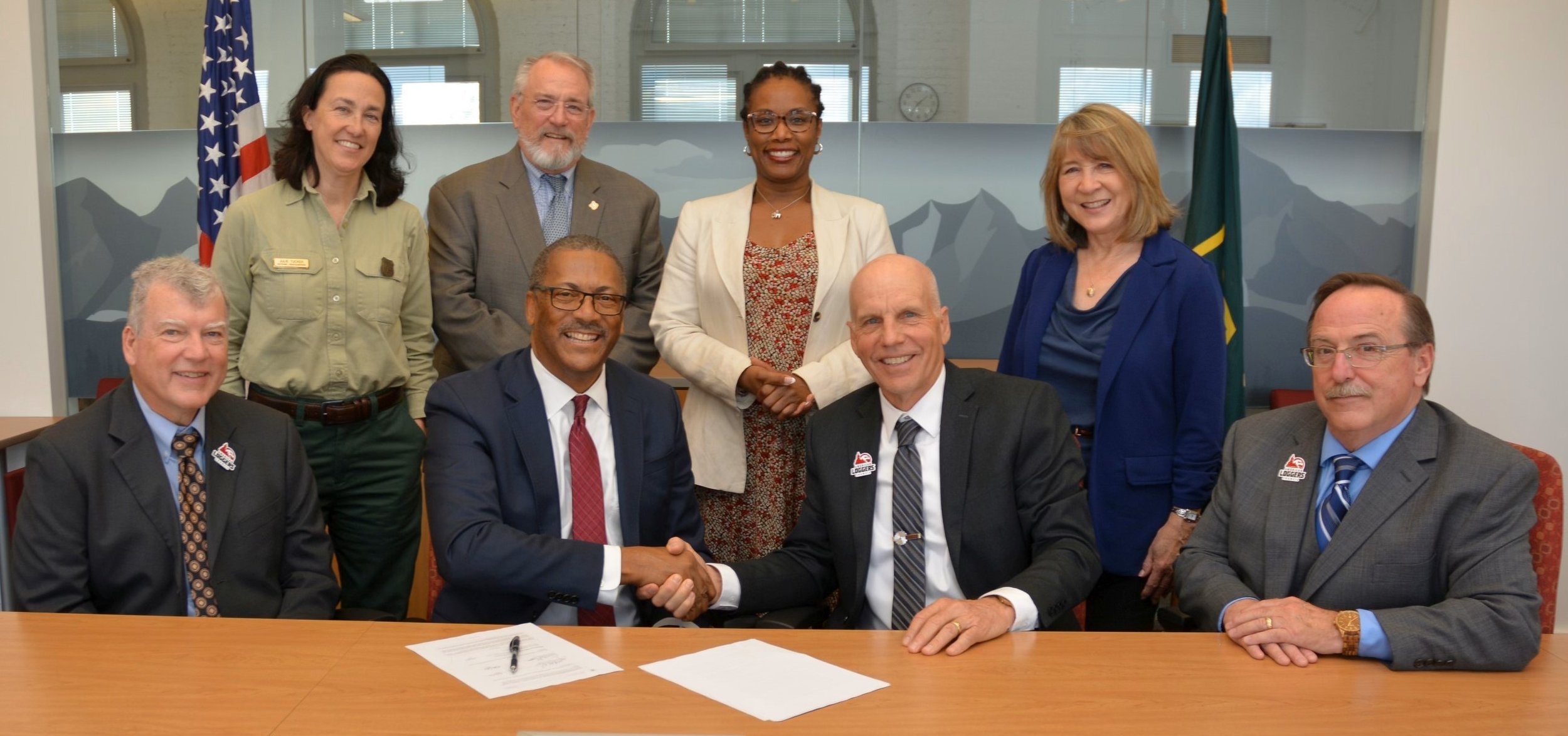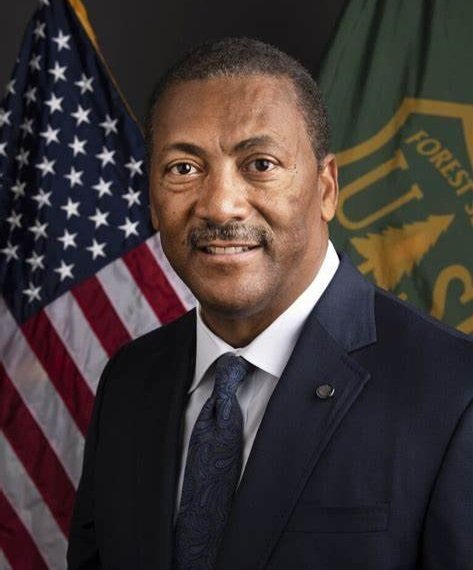A BETTER UNDERSTANDING
WRITTEN BY MIKE ALBRECHT, ALC PRESIDENT
On May 16, 2024, I had the distinct pleasure and honor of cosigning, along with Forest Service Chief Randy Moore, a “Memorandum of Understanding” between the American Loggers Council (ALC) and the USDA Forest Service.
Initiated by the Forest Service, this MOU was fully endorsed by the American Loggers Council Board of Directors at our April 19th Spring Meeting. Our ALC Executive Director, Scott Dane, deserves tremendous credit for steering this MOU effort, working with key Forest Service staff through sessions of editing and compromise.
The final result is a document titled “American Loggers Council and USDA Forest Service Collaborative Efforts for Healthy Forests, Markets, and Logging Industry.”
At this point, I suggest you let that rather lengthy title “sink in” for a moment. No, it is not a misprint. This title now represents what every American logger and every Forest Service employee should understand. We are now encouraged and expected to work collaboratively (read: together) to produce healthy forests, healthy timber markets, and a healthy logging industry.
To further underscore what we should all now understand, the MOU has a “Statement of Mutual Benefits and Interests.” I will quote a portion of these mutual interests as follows:
“The Forest Service utilizes professional logging contractors and timber haulers through various contracts and agreements to accomplish forest restoration and hazardous fuels treatment projects on National Forest System (NFS) lands. The ALC works to support, as part of its mission, an economically viable, healthy, and sustainable logging workforce with a ready supply of timber and restoration byproducts and robust markets to deliver raw materials. The Forest Service depends on an adequate professional logging/hauling contract workforce to bid on Forest Service timber sales and contracts along with robust markets to deliver material to so that the National Wildfire Crisis Strategy and the goal of accelerating the pace and scale of forest restoration can be accomplished and sustained into the future.”
Back row, from left to right: Julie Tucker (National Program Manager for Wood Innovations – Bioenergy, Biofuels, and Bioproducts), Steven W. Koehn (Director for Cooperative Forestry; State, Private, and Tribal Forestry) Andria Weeks (Associate Deputy Chief for State, Private, and Tribal Forestry) and Vicki Albrecht, (ALC Presidents Wife) Front Row: David Cupp (ALC 2nd Vice President), Randy Moore (Chief of the USDA Forest Service), Mike Albrecht (ALC President), and Scott Dane (ALC Director)
The press release that followed the MOU signing quotes Forest Service Chief Moore saying, “Loggers are on the front line every day, contributing directly to the health of the nation’s forests . . . while also creating jobs and strengthening local economies.” And I added to that: “America’s loggers are the “boots on the ground” providing essential wood products while helping to protect and restore our forests to their fullest potential. We cannot do our job without a strong working relationship with the United States Forest Service.”
In the discussions that followed the signing of this MOU, one of the Forest Service officials was inspired to say, “We are a team; we can’t exist without each other.” Well, if we are truly a team, and our goal is “working together for healthy forests, markets, and logging industry” . . . then who are we competing with? My answer: up until recently, there hasn’t been any other team – we’ve been faced off against each other.
Many, if not most, of you are better historians than me, although I find history fascinating and insightful. In my opinion, the best book chronicling the history of American forestry was published back in 1971. Written by Henry Clepper, it is titled Professional Forestry in the United States. No, it doesn’t include the past 50 years, but it does provide a detailed and accurate accounting of the storied events that shaped America’s current forest management policies.
Chapter 1 is aptly titled, “The Plunder of the Pineries,” recalling when loggers and lumbermen operating in the 1800’s were described as, “villains, scoundrels, and thieves.” Chapter 10, titled, “Timber Famine Warnings: Prelude to Regulation,” ushers in the notion that America’s forests would soon be depleted. This concern gave birth to the US Forest Service and two teams. The American timber industry and the Forest Service began to battle in an undeclared war, perpetuated by misunderstanding.
Forest Service Chief Randy Moore stated, “Loggers are on the front line every day, contributing directly to the health of the nation’s forests . . . while also creating jobs and strengthening local economies.” And I added to that: “America’s loggers are the “boots on the ground” providing essential wood products while helping to protect and restore our forests to their fullest potential. We cannot do our job without a strong working relationship with the United States Forest Service.”
There were cease-fires along the way that allowed for progress. America’s wildfire events gave birth to Smokey the Bear, who became the Forest Service symbol for an effective wildfire prevention program, and despite a litany of government regulations, America built a vibrant timber industry.
But misunderstandings continued to polarize the two sides, prompting Henry Clepper to note that, “to more than one contemporary observer, it appeared strange that, as industrial forestry became better, the attitude of the regulators became more critical.” As the design of logging equipment became more environmentally friendly, more public land was designated as wilderness, near natural, wild and scenic, and roadless. Timber operators are now licensed and take continuing education courses but remain untrustworthy in the eyes of many within an agency I still hear referred to as the “Forest Circus.”
The bottom line is that in 2024, even though America’s forests now cover almost 800 million acres, we have become the world’s leading importer of softwood lumber. We are losing sawmills at the rate of about two per month. Over the past ten years, the Forest Service has lost 40% of its non-firefighting workforce.
It’s time for a reset.
Enter the 2024 ALC/USFS Memorandum of Understanding. This historic and very positive document outlines a path forward to promote the three priorities listed in its title: Healthy Forests, Healthy Markets, and a Healthy Logging Industry. It underscores the following statement made recently by Chief Moore as he addressed the Department of the Interior Appropriations Subcommittee: “I can tell you with certainty that if we do not have a vibrant timber industry, we are not going to be able to manage our forests and keep them healthy and resilient.”
Let me say with certainty that the American Loggers Council completely agrees with Chief Moore’s statement, but a final step is required to make the MOU more than 3 holes punched into a binder. It needs to be circulated, read, and understood. Every Regional Forester should brief his/her staff. Every Forest Supervisor and District Ranger should brief their staff and employees. To have teeth, the concepts in this MOU need to be integrated into forest plans and there needs to be accountability showing progress in achieving the stated goals.
Every state logging association needs to share this MOU with their Board of Directors, passing it on to all their membership. The only way this MOU will result in additional acres treated, fires prevented, and more wood products for America, is to have it communicated through the Forest Service and the timber industry, thoroughly understood, and transformed from a “Memorandum” into an “Action Plan.”
I request that you read the Memorandum of Understanding for yourself. All the main points are discussed in the first 3 ½ pages. It takes ten minutes to read and understand it. If and when we agree with it, the doors of “understanding” and “action” open wider. VIEW OR DOWNLOAD THE MEMORANDUM OF UNDERSTANDING >>
The American Logger A Legacy of Achievement
Mike Albrecht has a master’s degree in forestry from Duke University, is a Registered Professional Forester in California, and has worked for over 45 years in forest management and the forest products industry. Mike currently serves as president of the American Loggers Council and is a past president of Associated California Loggers and the Sierra Cascade Logging Conference.



